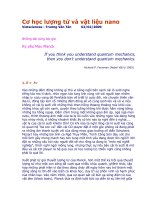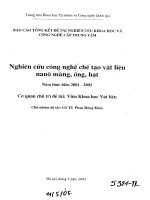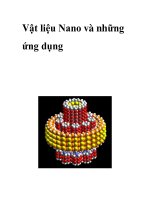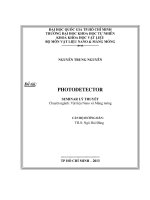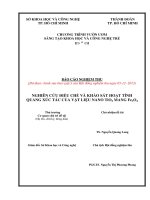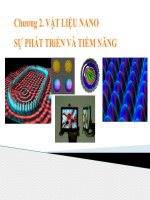Slide vật liệu nano và màng mỏng microfkuidic devices
Bạn đang xem bản rút gọn của tài liệu. Xem và tải ngay bản đầy đủ của tài liệu tại đây (2.14 MB, 32 trang )
.c
om
du
o
ng
th
an
co
ng
Microfluidic Devices
cu
u
Thuy. N.T. Nguyen
1
CuuDuongThanCong.com
/>
Contents
co
an
th
ng
u
Sensor
du
o
Pump
Valve
Mixer
Channel
Reactor
ng
.c
om
Introduction
Components of microfluidic devices
cu
Structure of Microfluidic device
Design Structure and Fabrication
Application
2
CuuDuongThanCong.com
/>
Introduction
cu
u
du
o
ng
th
an
co
ng
.c
om
• Total analysis system (TAS): was first introduced in
1980s for analysis in chemical as well as biochemica
l.
• Micro total analysis system (µTAS): was first develop
ed in 1990s. µTAS combines microfluidics, mechanic
al actuators, and transducers for complete analysis i
n micro chip.
• Now µTAS was broaden to synthesize and other app
lication. In general, it was known as Microfluidic devi
ce or Lab on a chip devices.
3
CuuDuongThanCong.com
/>
Microvalve
Depend on the strength of fl
ow, we have stiffness of flap
.
an
co
ng
.c
om
• Passive valve (check valve): no actuation for
control, unidirectional flow.
ng
th
flow
cu
u
du
o
• Active valve: require an actuator to provide a
mechanical action. The actuation include
piezoelectric,
electrostatic,
electromagnetic,
pneumatic, thermopneumatic actuation, bistable,
phase-change.
4
CuuDuongThanCong.com
/>
Microvalve
Electric: static, piezo
Magnetic
Thermal expansion
Ultrasonic
Design
.c
om
Flow rate (velocity, dimension)
size of valve stiffness of memb
rane relate to material, dimension
deflection applied force c
hoice the actuation.
Actuator
ng
Controller
an
co
Actuation
u
In micro fluidic:
du
o
ng
th
membrane
cu
Membrane: silicon or glass ( often 50 µm thickness, 2mm x 2mm), sometimes poly
mer.
Glass/silicon were wet etching by HF/KOH or dry etching. Then they were anodic
bonding.
5
CuuDuongThanCong.com
/>
.c
om
ng
co
an
th
ng
du
o
u
cu
6
CuuDuongThanCong.com
/>
.c
om
ng
co
an
th
ng
du
o
u
cu
7
CuuDuongThanCong.com
/>
.c
om
ng
co
an
th
ng
du
o
u
cu
8
CuuDuongThanCong.com
/>
.c
om
ng
co
an
th
ng
du
o
u
cu
9
CuuDuongThanCong.com
/>
.c
om
ng
co
an
th
ng
du
o
u
cu
Bistable valve
10
CuuDuongThanCong.com
/>
.c
om
Micropump
an
co
ng
Micro pumps are used for pumping fluid into
micro channel.
Classified micropumps
cu
u
du
o
ng
th
• Mechanical pump (reciprocate or rotary)
• Non mechanical pumps (pressure driven, electro
kinetic flow, diffuser/nozzle…).
• Valve pumping action / Valveless pumping action.
11
CuuDuongThanCong.com
/>
.c
om
ng
co
an
th
ng
du
o
u
cu
12
CuuDuongThanCong.com
/>
.c
om
ng
co
an
th
ng
du
o
u
cu
13
CuuDuongThanCong.com
/>
.c
om
ng
co
an
th
ng
du
o
u
cu
14
CuuDuongThanCong.com
/>
.c
om
ng
co
an
th
ng
du
o
u
cu
15
CuuDuongThanCong.com
/>
.c
om
ng
co
an
th
ng
du
o
u
cu
16
CuuDuongThanCong.com
/>
Valveless pumping action
Principle working
co
ng
.c
om
Diffuser/Nozzle pumps
an
Schematic of diffuser pump
ng
th
Bernoulli: (static pressure) + (dynamic pressur
e) x (pressure loss coefficient)= const
Pd
d
2
Diffusion action
u
2
cu
vd
du
o
So ξ is high, the energy of flow decrease fast
Pn
vn
2
2
n
Nozzle action
If ξn is greater ξd, pumping action
will occur.
ΔPd , ΔPn : pressure across the
diffuser, nozzle
ξd, ξn : pressure loss coefficient
Vd, Vn: mean velocities
17
CuuDuongThanCong.com
/>
J. Micromech. Microeng. 12 (2002) 420-424
PZT: 6x6 mm2, 250 um thickness
(PZT-5H plate from Morgan Matroc Ltd)
an
co
ng
.c
om
Si membrane: 7mm x 7mm x 70um
th
Valve
u
0.6 mm
cu
12mm
du
o
ng
Bonding
PZT glued with Si m
embrane by conduct
ive epoxy
12mm
18
CuuDuongThanCong.com
/>
.c
om
ng
co
cu
u
du
o
ng
th
an
Pump connect power
Test with ethanol, pump rate maxim
um 1500 µl/min at 2.5kHz, with bac
kpressure 1000 Pa.
Real measurement difference simul
ation because of:
- hydrodynamic phenomena
19
CuuDuongThanCong.com
/>
Flow transport by pressure/electrickinetic
.c
om
Pressure driven flow: parabolic profile velocity due to visc
osity.
th
an
co
ng
Electric-osmotic flow have band broadening due
to induced pressure gradient.
ng
Profile pressure
RT
du
o
cu
u
D
Journal of Colloid and Interface
Science 275 (2004) 670–678
2
2
2F z c
eo
o
4
R: universal gas constant
T: absolute temperature
F: Faraday constant
z: charge number
Schematic of electric d
ouble layer model
v eo eo E
c: concentration
ε: dielectric constant
20
CuuDuongThanCong.com
/>
Characteristics of fluid in micro scale
.c
om
Affected Force: capillary force (because of surface tension) inst
ead of inertia in macro flow.
co
ng
F cap 2 r cos
du
o
ng
th
an
Viscosity is significant effect.
High interface to volume ratio: interaction between liquid an surf
ace wall is strong high fluidic resistance. The smaller channel si
ze, the bigger fluidic resistance.
cu
u
With circular cross s
ection
resis
8 L
R
R: channel radius
L: channel length
4
η: viscosity
21
CuuDuongThanCong.com
/>
Mixer and channel
Mixer: to attain a homogeneous of two solutions in as little time as
.c
om
possible.
• Passive mixer: only base on diffusion (internal energy).
cu
u
du
o
ng
th
an
co
ng
• Active mixer: use external energy to induce turbulence.
22
CuuDuongThanCong.com
/>
Mixer and channel
.c
om
How to improve the mixing?
Passive mixer:
Reduce diffusion distance reduce time according to Einstein-Smoluchowski equation.
ng
Split channel into an array of smaller channels to increase the contact areas.
an
co
Form groove across the channel or block for change direction flow induce turbulence.
th
x
2 Dt
t: diffusion time
D: diffusion coefficient
du
o
ng
E-S equation
x: diffusion distance
cu
u
Active mixer:
Applied voltage across the mixing chamber.
Used pump to make bubble.
23
CuuDuongThanCong.com
/>
Sensor
ng
.c
om
In microfluidic, we need to measure
Flow rate (pressure, velocity) mechanical sensor (Piezoresistive or cap
acitive)
Temperature of flow temperature sensor
Concentration of solution optical sensor
th
an
co
Piezoresistive pressure sensor
pressure
(resistor)
cu
Sensitive element
u
(membrane)
+
du
o
ng
Elastic element
Polysilicon (0.5um) was d
Wheatstone bridge
eposited, doped.
Voltage
24
CuuDuongThanCong.com
/>
Micro Total Analysis System (μ_TAS)
.c
om
To design a µ_TAS, we must answer for What is purpose o
f device? Which is the fluid concern?
co
ng
Whether in chemical or in biology, device must be inert or c
ompatible with fluid.
+
reactor
u
preparation
Mixer /
du
o
Sample
ng
th
an
Common components of µ_TAS
cu
Injection (discrete/ co
ntinuous)
Filter
+
Separation
+
Detection
Electrophoresis
Mechanical
Chromatography
Electrical
Mass spectrocopy
optical
25
CuuDuongThanCong.com
/>

